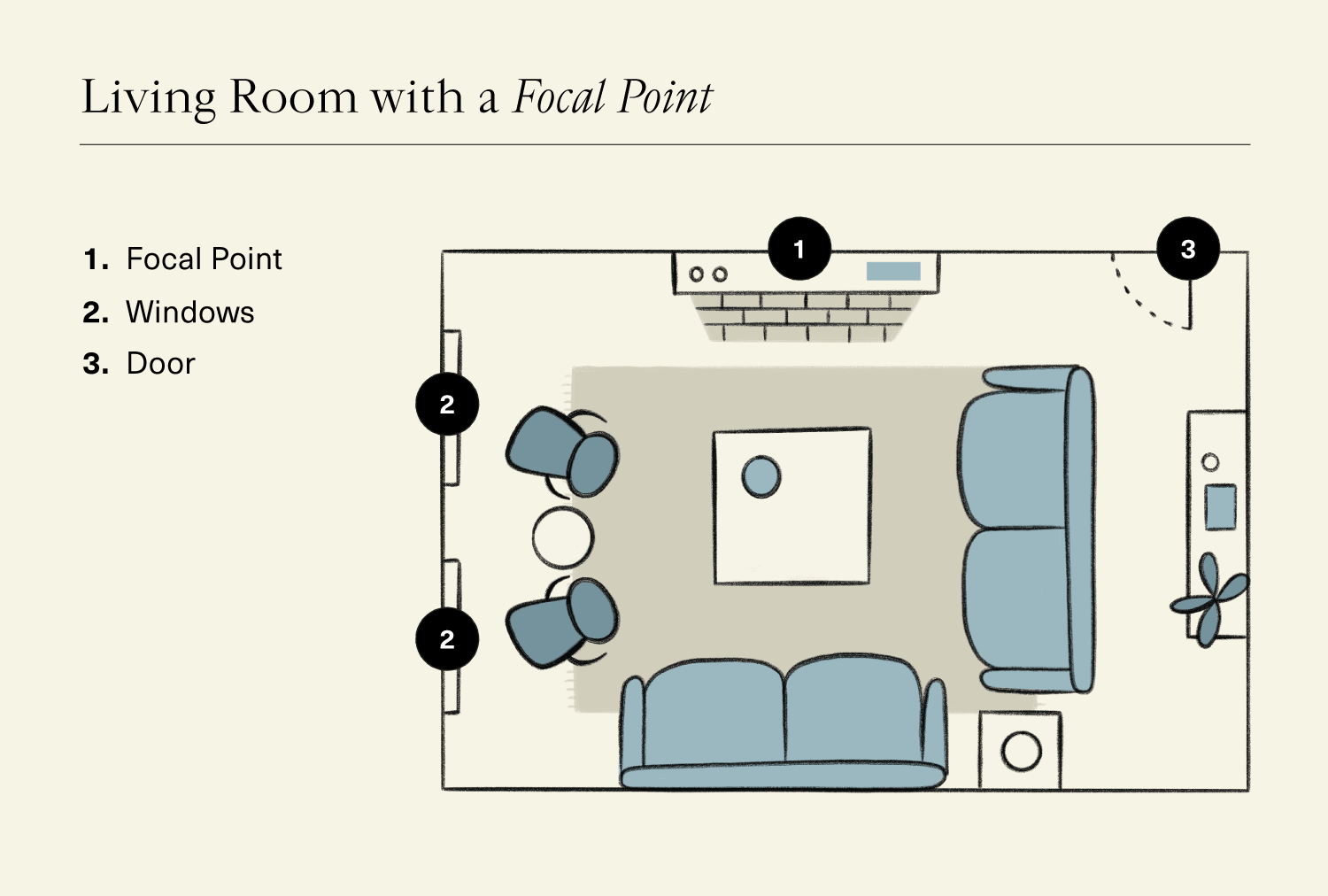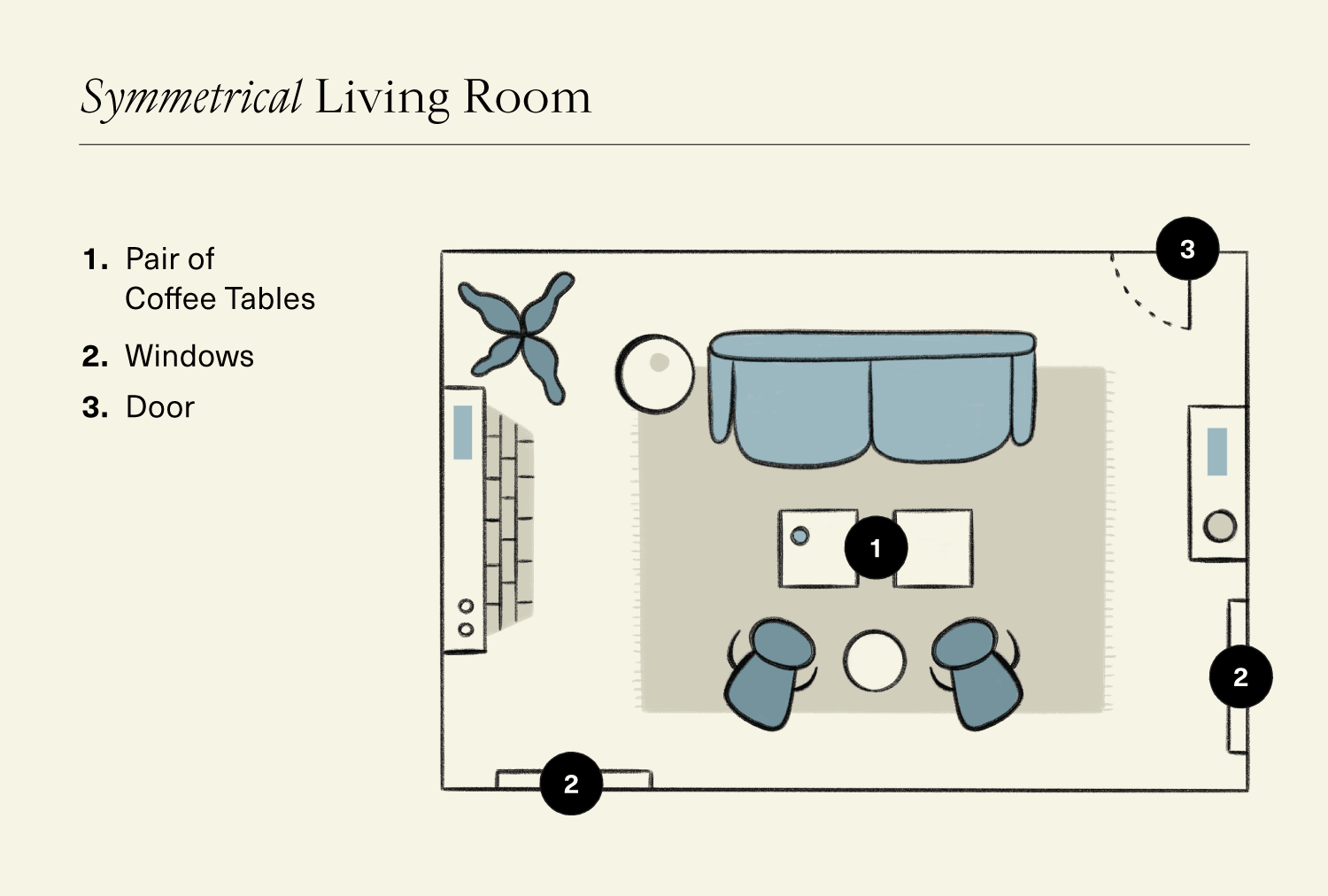a minute idea
Here in this small space via SMD decorations blog in Turkey, we will give you in this article, design ideas and how to arrange furniture, accompanied by the advice of some decorators, with examples of planning to help you create an ideal and beautiful living room.. Follow us.
It is easy to find yourself paralyzed by indecision when faced with an empty room. Arranging furniture and deciding where to place each element of your living space can be a difficult and time-consuming task.
Below we give tips on how to arrange furniture in the living room, many of which apply to all spaces in your home. First, we will give 12 indicators for a well-flowing layout design, followed by sample layouts that may suit your own living room. Next we will answer some common questions about the placement of furniture.

Let's start with several tried-and-true tips to help you arrange furniture and decor in your living room.
Draw a floor plan
It is better to start with a comprehensive plan. Take measurements of your room to create a layout using an online tool or an old-fashioned pencil and graph paper. Measure your existing pieces of furniture, then cut out pieces of paper to represent each piece, which you can move on the floor plan.
This process will help you determine what is most important to you when designing a room. Is it traffic flow, stylistic elements, facilitating conversations between visitors, or drawing attention to the entertainment system Once you have made a plan, you will have a better idea of where to start.

It is important to choose a focal point for your living room. It can be a fireplace, a bay window, a TV, a bookshelf, a coffee table or a piece of art. To decide then, and then ask yourself: What do you want people to notice first when they enter the room
Once you have chosen a focal point, you can design around it, Corner furniture and decor to attract the eye to it.

To balance your space, consider the shapes and colors of your furniture and decor. Assemble the pieces to create arrangements with an attractive variety of shapes and shapes.
One way to achieve balance is to combine items with bright decorations with neutral ones. For example, if you have a prominent colored chair, place it next to a muted decor while incorporating the same accent color elsewhere in the room. This will help make your space aesthetically pleasing and visually interesting.

It is important to create conversation zones in the living room. Place sofas and armchairs so that seated guests can talk to each other normally, without straining their necks or having to move furniture. In a small room, you can focus on just one place where people can sit and chat, but in a large room, you may want to create several such zones.
Creating conversation zones involves anticipating how people will use the space. By the same token, don't let a chair float by itself. Place it near the sofa where the babysitter can easily interact with others or to facilitate reading or other activities, pair it with a side table and a floor lamp.

In your main seating area, fasten the items together using a large rug. Make sure it's big enough to lie under all the furniture. The exception is large pieces, such as a sofa, which can sit with their front legs and back legs from the carpet.
6. Consider the flow of traffic
Style is a big part of furniture design, but traffic flow is more important in creating a functional space. Make sure there is a clear and comfortable path around the room for people to navigate. To do this, place furniture at a distance of several feet - even in places where people walk a lot.
Lighting layer
To produce attractive layers of lighting in your room, use a combination of sources: overhead fixtures for the production of ambient light, sconces or floor lamps for accent lighting and table lamps for task lighting. For variety, arrange the heights of different sources. Point the compositions in different directions so that they resemble each other in interactive ways. Pair floor lamps with chaise lounges, and use elegant table lamps on side tables to lighten dark corners.
Think about the scale and ratio
Taking the size and proportion into account will help you assemble pieces of furniture with natural-looking arrangements. Scale indicates the size of the object.
The ratio indicates the relationship between the sizes of different objects.For example, a large piece of furniture can be balanced by two smaller pieces. That is why placing two chairs on the opposite side of the sofa is often a stylish and practical choice.You can also think about diversifying the height of your decor elements. Diversify the heights of the backs of the chair, the placement of works of art and accessorieson a table or shelf.
The introduction of some breathing chambers
It can be tempting to push furniture towards the walls to free up some space. However, pulling several feet, or at least several inches, out of the wall provides more breathing space and makes the interior space seem larger. For example, moving a characteristic sofa and chair closer to the center of the room can help create better airflow as well as more comfortable conversation areas.
Ideas for design -arm-length tables from seating
A good rule of thumb is to place the tables at an arm's length from the seating. For example, place a coffee table about 18 inches from the sofa so that it is within reach but not too close.
If you want to place side tables at each end of the sofa, then all the pieces should be approximately the same height so that the arrangement looks uniform.
Ideas for design and how to arrange furniture-keep the Windows Free
In general, you will need to arrange your furniture so that it does not clog your windows, thereby allowing natural light to pass through and illuminate the room. Placing the sofa under the window is fine as long as there are several inches of space between the top of one and the bottom of the other.
Connect it all with artwork
Finally, a great way to tie your design together is to choose wall art paintings that complement the decor and your color scheme. Above a sofa or console table is a good place to hang a work of art. Make sure that the work is large enough to be fixed on the furniture - it should extend by two thirds of the width of the piece under it.
For more specialized tips on home decoration, you can browse the rest of the articles in which we have elaborated on the world of interior design for each space.
Here we leave you with some layouts of living room furniture...


